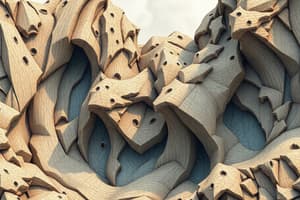Podcast
Questions and Answers
What is the defining characteristic of a recumbent fold?
What is the defining characteristic of a recumbent fold?
- It is a secondary structure in folded rocks
- It has undergone 180 degrees rotation
- It is a partially overturned fold (correct)
- It has straight limbs and sharp hinges
What distinguishes domes from basins?
What distinguishes domes from basins?
- Domes are semi-spherical, basins are semi-ellipsoidal
- Domes have older rock layers in the center, basins have younger rock layers in the center (correct)
- Domes have the youngest rock layers on the outer limbs, basins have the youngest rock layers in the center
- Basins are typically represented by concentric rings, domes are not
What type of stress typically leads to the formation of chevron folds?
What type of stress typically leads to the formation of chevron folds?
- Compressive stress (correct)
- Tensile stress
- Normal stress
- Shear stress
What distinguishes ptygmatic folds from disharmonic folds?
What distinguishes ptygmatic folds from disharmonic folds?
In a folded rock structure, what are parasitic folds?
In a folded rock structure, what are parasitic folds?
What causes plunging folds to form?
What causes plunging folds to form?
Which criterion is used to classify the tightness of folding?
Which criterion is used to classify the tightness of folding?
What is the defining characteristic of a dome?
What is the defining characteristic of a dome?
What feature distinguishes chevron folds from other types of folds?
What feature distinguishes chevron folds from other types of folds?
Why do ptygmatic folds appear chaotic and disjointed?
Why do ptygmatic folds appear chaotic and disjointed?
What causes basins to appear as deep rounded depressions?
What causes basins to appear as deep rounded depressions?
In what type of fold do parasitic folds form?
In what type of fold do parasitic folds form?
What type of rock layers typically cause the formation of chevron folds?
What type of rock layers typically cause the formation of chevron folds?
Why do plunging folds have an inclined hinge?
Why do plunging folds have an inclined hinge?
What distinguishes thickly-bedded rocks in terms of folding?
What distinguishes thickly-bedded rocks in terms of folding?
What classification criteria indicates isoclinal folds?
What classification criteria indicates isoclinal folds?
Flashcards are hidden until you start studying



